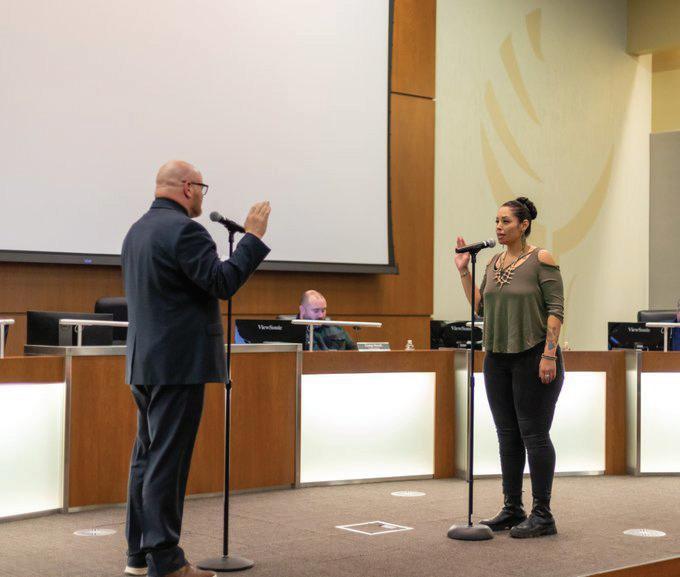
12 minute read
VOLUME 35 ISSUE
BY SCOTT TAYLOR STAYLOR@COLORADOCOMMUNITYMEDIA.COM
Commerce City will invite speakers from the legendary World War 2 ghter pilots the Tuskegee Airmen to speak at a Black History Month celebration, councilors agreed.
“ e Tuskegee Airmen can come to our city, and we would like to make it a big special event for the whole city,” Councilor Jennifer Allen- omas said during the council’s special meeting on Jan. 9. “ e cost is $1,500 and the event would be possibly scheduled on Feb. 23. Our City Manager is aware of this, our sta is aware of the situation as well. We want to make this a big event and would welcome the entire Commerce City community. We are hoping to have this event at the Civic Center building.”
Councilors agreed unanimously and directed sta to work out the details. e Tuskegee Airmen were a group of 932 ghter and bomber pilots and their support crews who trained at Tuskegee Army Air eld in Alabama. Of that group, 355 ew some 1,500 missions in Europe between 1942 and 1946. e pilots were mostly African American and they were the rst aviation unit of their kind during a time when the U.S. military was still racially segregated and many U.S. states still had Jim Crow laws on their books. e unit had an excellent combat rating, was highly praised by military commanders and earned six Distinguished Unit Citations while its members earned 96 Distinguished Flying Crosses.
“One of the original Tuskogee Airman is still alive,” Allen- omas said. “He’s is 100 years old, and hopefully he’ll be able to attend this event as well.”

Members of the 477th Bomb Group, a unit of the Tuskegee Airmen, pose for a picture in 1944. Commerce City is inviting speakers from the group to come for a Black History Month celebra-
tion. COURTESY THE TUSKEGEE AIRMEN ARCHIVES
Walk with a doc
Platte Valley Medical Center’s cardiac rehab team and Walk With A Doc will host monthly walks with Dr. Christopher Cannon, an interventional cardiologist at Brighton Heart and Vascular Institute. is is a walking program for everyone interested in taking steps for a healthier lifestyle. After a few minutes to learn about a current health topic from the doctor, spend the rest of the hour enjoying a healthy walk and fun conversation. It’s a great way to get out, get active and enjoy all the bene ts that come from walking.
Boards/commissions’ openings
Commerce City has openings for several of its boards and commissions, including the city’s cultural council, the housing authority and the Derby review board. aVisit https://www.c3gov.com/Home/Components/Form/Form/70316b05422c448492c51da0f 0e0fd86/ to sign up.
Legal self-help clinic
e Access to Justice Committee hosts a free, legal self-help clinic from 2 to 3:30 p.m. the rst Tuesday of every month. e program is for those who don’t have legal representation and need help navigating through legal issues.
Volunteer attorneys are available to discuss such topics as family law, civil litigation, property and probate law. Call 303-405-3298 and ask for the Legal Self-Help Clinic at least 24 hours in advance.
Help for vets
Quali ed Listeners, a veteran and family resource hub serving northern Colorado and southern Wyoming, has a number of power chairs, power scooters and electric wheelchairs available.
To nd the closest facility to you visit www. va.gov/ nd-locations.
Quali ed Listeners also need volunteers to drive veterans to and from appointments, run errands for veterans who cannot get out, handyman services, help administer veteran and family resource guide inventory in local libraries and veterans to be trained to become quali ed listeners. Call 720-600-0860.
COVID-19 testing
Here’s where you can receive a test for COVID-19:
Brighton Advanced Urgent Care, 2801 Purcell St. Call 303-659-9700 or visit https://advurgent. com/locations/brighton/
Brighton Salud, 1860 Egbert St. Testing is available on Tuesday, ursday and Friday. Visit https://www.saludclinic.org/covid-testing
Fort Lupton Salud, 1115 Second St. Testing is available on Tuesday and ursday. Call 303-6972583 or visit https://www.saludclinic.org/covidtesting online.
Mental health
Community Reach Center o ers in-person intake assessments from 8 a.m. to noon Tuesdays at the Brighton Learning and Resource Campus, 1850 E. Egbert St. in Brighton. Call Community Reach Center at 303-853-3500.
For walk-in intake, bring an ID and insurance information. For those who would prefer to complete the intake forms and schedule an appointment, the intake forms are available online at www.communityreachcenter.org. ere will be a short screening for u-like symptoms before the entrance to the center to ensure safety and wellness for everyone.
Anyone feeling unsafe or suicidal should call Colorado Crisis Services at 1-844-493-8255, text 38255, or visit the Behavioral Health Urgent Care (BHUC) Center at 2551 W. 84th Ave., Westminster.
Warm Line up and running
Community Reach Center is o ering a Warm Line (303-280-6602) for those who want to talk to mental-health professionals about anxiety, lack of sleep and strained relationships, among other topics. e professionals can facilitate referrals to other programs for assistance.
A press statement said the line is not for crisis intervention. ose feeling unsafe or suicidal should call Colorado Crisis Services (1-844-493-8255) or text 38255 or visit the Behavioral Urgent Care Center, 2551 W. 84th Ave., Westminster.
Also, the center’s COVID-19 Heroes Program is set up to assist healthcare workers during the pandemic. ose who live or work in Adams County can receive up to six free counseling sessions. Use the Warm Line for support and free counseling.
Brighton’s community intake location is at 1850 E. Egbert St., on the second oor. It’s open from 8 a.m. to noon Tuesdays.
Food distribution
27J Schools have free grab-and-go meals for youngsters up to age 18. Drive-by or walk up between 11 a.m. and 1 p.m. Mondays, Wednesdays and Fridays at Vikan Middle School, 879 Jessup St., Overland Trail Middle School, 455 N. 19th Ave., and at Thimmig Elementary School, 11453 Oswego St. Food for Hope is the sponsor.
St. Augustine food pantry, 129 S. Sixth Ave., offers food Tuesdays and Thursdays from 9 a.m. to 1 p.m. for Brighton residents who love between Quebec St. and Cavanaugh Road and between Weld County Road 4 1/2 and 96th Ave.
Chapel Hill Church, 10 Chapel Hill Drive, Brighton, hands out one box of food per family the second and fourth Wednesdays from 4 to 5:30 p.m. and alternating Saturdays at 9:30 a.m.
Calvary Chapel Brighton Food Pantry, 103 E. Bridge St., Brighton. Open from 4 to 6 p.m. on the second and fourth Mondays of the month.
Community Baptist Church Food Pantry, 15559 Weld County Road 2, Brighton. Open from 11:30 a.m. to 2:30 p.m. Tuesdays.
Volunteers needed
Quali ed Listeners needs volunteers to drive veterans to and from appointments, run errands for veterans who cannot get out, handyman services, help administer veteran and family resource guide inventory in local libraries and veterans to be trained to become quali ed listeners.
Visit quali edlisteners.org/volunteerapp and ll out the form or call 720-600-0860.
ENTINEL EXPRESSSC O M M E R C E C I T Y 50c I
A publication of
LINDA SHAPLEY
Publisher
lshapley@coloradocommunitymedia.com
MICHAEL DE YOANNA
Editor-in-Chief
michael@coloradocommunitymedia.com
SCOTT TAYLOR
Metro North Editor
TERESA ALEXIS
Marketing Consultant Classifi ed Sales
talexis@coloradocommunitymedia.com
AUDREY BROOKS
Business Manager
Columnists & Guest Commentaries
Columnist opinions are not necessarily those of the Sentinel Express. We welcome letters to the editor. Please include your full name, address and the best number to reach you by telephone.
Email letters to
staylor@coloradocommunitymedia.com
Deadline
Wed. for the following week’s paper.
Commerce City Sentinel Express (USPS 3886)
A legal newspaper of general circulation in Commerce City, Colorado, Commerce City Sentinel Express is published weekly on Thursday by Colorado Community Media, 143 S. 2nd Pl., Brighton CO 80601. PERIODICAL POSTAGE PAID AT Commerce City and additional mailing o ces.
The Long Way Home
Examining the impacts of the housing crisis
People across the metro area are struggling to a ord a place to live. Minimum wage earners might spend upwards of 60% of their paychecks on rent. Many millennials, now entering their 40s, have accumulated less wealth than prior generations and are struggling to nd a rst home they can a ord. At the same time, those who might sell, baby boomers, are prone to hold onto their homes, unable to downsize in the supercharged market. ese and other factors, including homelessness, a history of racial disparities where 71% of white Coloradans own homes but only 42% of Black Coloradans do, and a slow down in building that began more than a decade ago during the Great Recession, add up to constitute what some experts call a crisis in housing a ordability and availability.
Over the last six months, two dozen journalists, editors and sta at Colorado Community Media worked to answer questions on why this is happening, how we got here and what the solutions are. e work to nd the answers carried our journalists along the Front Range to talk to mayors, housing authorities, experts and, most importantly, lower- and middle-class families experiencing the crisis rst hand.
Our reporters and editors also held focus groups, talking directly to prospective homebuyers, like the single mom worried that another rent increase could land her in her car and the real estate agent who understood the problems but worried about a lack of solutions.
Over the next four weeks, Colorado Community Media provides an in-depth look at how the current crisis impacts our communities. In Week 1, e Long Way Home breaks down how we got here. On Week 4, we look at how local, state and federal governments are investing millions of dollars into a range of possible solutions – from helping the homeless to a ordable housing programs.

Contributors to theproject include:

TRICKLING UP
From work to school to neighborhood events, the program has created a way for Gilson’s family to be a part of a community. With housing and communities come resources, though not all are created equal. Gilson explained that in her prior communities — predominantly lower socioeconomic status and people of color — it resulted in a lack of resources, such as academic and mental health. at’s why she moved to Westminster, where she has lived for 12 years.
“I wanted my kids to have a stable education and stable housing,” she said.
It’s not just low-income residents who struggle to a ord housing. Across the metro area and along the Front Range, rising in ation and mortgage rates, a long-term building slowdown and increasingly crowded cities and towns have combined to create what some observers and experts say is a housing crisis.
More and more people throughout the metro area are nding the cost of renting or buying a home eating up signi cant portions of their budgets.
“ at’s the No. 1 reason that people move, is they can’t keep up with their rent (and) utilities payments,” said Heidi Aggeler, managing director and co-founder of Root Policy Research, a Denver-based community planning and housing research rm. ere’s a term for it: “cost-burdened,” which describes households paying more than 30% of their income on housing. A little more than 700,000 households in Colorado are cost-burdened, most of which are renters, according to a November 2021 report from Root Policy Research.
“We’ve never done a very good job of housing extremely low-income people and families and helping to move them out of poverty,” Aggeler said. “We’ve never had enough resources to adequately address that.”
People who make $25,000 or less a year have long faced a housing crisis on some level, Aggeler said. But now, the number of people who make more money and are feeling the pinch of high housing costs is growing.
It has become increasingly common for middle-income households with incomes of roughly $35,000-$75,000 to experience cost burden, according to Root Policy Research.
As long as Colorado continues to be an attractive place for people to move to, invest in and retire, Aggeler thinks housing challenges will continue. ere are also too few options for would-be buyers. Many nd the cost of single-family homes beyond their reach but have few options a step below that, such as condos.
“If you believe that Colorado will be a place that employers will continue to want to move to, then I think … the outlook may not be good unless we accelerate production and density and fund housing at the level that is needed,” Aggeler said.
The cost of housing
Practically every community in the metro area is facing its own housing a ordability and availability issues. South of Denver, in Lone Tree, Mayor Jackie Millet said there is a “housing crisis.”
“I think it varies in severity throughout our state, but I do think it is a problem that is a ecting all of Colorado,” she said. “ ere’s so much supply pressure on our market right now that we have, then, created this crisis.”
Not everyone is describing it as a crisis, but those who use that word point to the numbers across the metro area, as the costs of singlefamily homes and townhomes have skyrocketed.
Northwest of Denver, in Arvada, the median sale price of a singlefamily home was $667,000 as of late 2022, according to the Colorado Association of Realtors. at’s up by 71% from 2017, when the price was around $390,000. e story is similar in Brighton, northeast of Denver, where the median sale price increased by approximately $225,000 over that period.
Littleton, south of Denver, saw an increase of approximately $300,000 in the price of single-family homes from 2017 to 2022.
Lone Tree saw an increase of $473,750.
“What we have seen is our housing prices doubling and our wages have not been keeping up,” Millet said.
From 2000 to 2019, median rents rose at a faster rate than median renter household incomes did “in every Colorado county and city with 50,000+ residents,” according to Root Policy Research.
Many residents want a home of their own, Millet said.
“ at was our ultimate goal, and that is also the way most of us accumulated wealth,” she said.
When the cost of buying or renting is too high, however, people cannot establish these roots, she added.
Supply versus demand
One of the main causes of the rise in cost-burdened households and lack of a ordable housing is that production has failed to keep up with demand. ere was a 40% decrease in the number of homes built between 2010 and 2020 in Colorado, according to the 2022 “A ordable Housing Transformational Task Force Report.”
Susan Daggett, executive director of the Rocky Mountain Land Use Institute, said the crash of 2007 a ected housing supply. People left the construction industry and many companies went bankrupt.
“ e housing market bottomed out, people left the construction industry, a lot of people went bankrupt,” she said.




